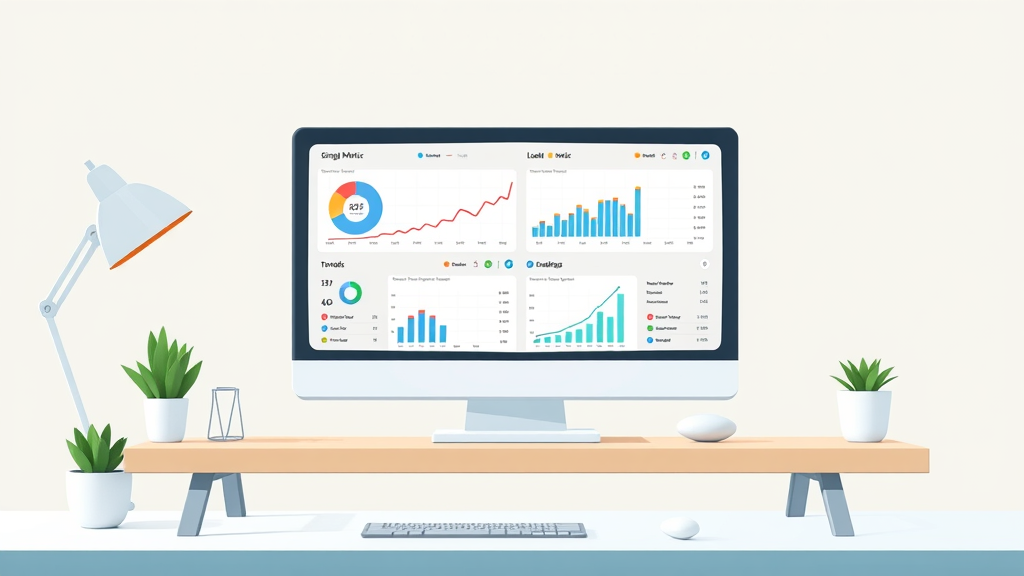Boost Rankings Fast With These SEO performance metrics

Are you confident you’re tracking the right SEO performance metrics—those that actually move the needle and ignite real ranking results? SEO is more data-driven than ever, but only a handful of powerful metrics separate winners from wasted effort. Imagine skyrocketing your search engine rankings just by measuring what matters most. In this comprehensive guide, you’ll discover how to unlock rapid SEO performance, find the vital metrics to monitor, and craft strategies proven to push your website to page one. Let’s dive in and transform the way you approach SEO success—starting today.
Are You Tracking the Right SEO Performance Metrics for Rapid Growth?
- What SEO performance metrics are and why they matter
- Which SEO metric impacts rankings most
- How to leverage SEO metrics for improved SEO performance
- How to measure SEO success using real tools
- Actionable strategies to boost your SEO using performance metrics
- How to interpret organic traffic, keyword ranking, conversion rate, and more

Understanding SEO Performance Metrics: Foundations for SEO Success
What Are SEO Performance Metrics and Why Are They Important?
SEO performance metrics are quantifiable data points that reveal how effective your search engine optimization strategies are at driving results. Think of them as your SEO effort’s scorecard—they show whether your strategies are attracting organic traffic, improving keyword rankings, and converting visitors into customers. Without these metrics, your SEO strategy is like navigating without a map: you might move, but not necessarily in the right direction. By systematically tracking and analyzing key SEO metrics, marketers make data-driven decisions, refine content, address technical SEO issues, and ultimately drive SEO success.
SEO metrics encompass everything from basic indicators—like organic search traffic and bounce rate—to more advanced signals such as conversion rate, site performance, and number of referring domains. Each metric serves to answer a crucial question about your site’s SEO health: Is your content resonating with users? Are you gaining authority through backlinks? Are your pages performing in the search engine results the way you expect? Understanding and acting on these metrics enables marketers to focus on what drives the most impact, turning data into higher rankings.
Critical SEO Metrics for Evaluating SEO Success
Not all SEO metrics carry the same weight; some directly influence your rankings, while others provide clues to user behavior or technical bottlenecks. Organic traffic remains the bedrock of SEO performance metrics, offering direct insight into visibility and reach across search engines. Equally significant are keyword ranking and keyword rankings—these show how well your content competes for target search terms. Bounce rate helps diagnose user experience and landing page relevance, while conversion rate demonstrates the real business impact of your SEO effort. Monitoring referring domains showcases improvements in site authority, and site performance metrics highlight essential technical SEO areas, such as load speed or mobile friendliness.
To get a full portrait of your SEO health, evaluate these metrics together, using a robust tracking tool or analytics dashboard. When these metrics trend positively in harmony, you know your SEO efforts are both effective and efficient—ultimately leading to measurable SEO success.
“Without accurate performance metrics, your SEO strategy is just a shot in the dark.” – SEO Industry Leader
SEO Metric vs SEO Metrics: The Key Differences
Many marketers use the terms “SEO metric” and “SEO metrics” interchangeably, but there’s a subtle distinction. An SEO metric refers to a single, specific measurement (such as bounce rate or keyword rank), while SEO metrics refers to the collection of these data points that together inform the overall health of your SEO performance. Relying on just one SEO metric—say, organic traffic—without considering others like conversion rate or site performance can provide a skewed view. It’s only when the various SEO metrics are viewed together that patterns and actionable insights emerge.
For instance, a spike in traffic looks promising, but if the bounce rate is equally high, your content or user experience might be lacking. Combining multiple SEO metrics allows you to diagnose challenges and capitalize on what’s working, forging a path to consistent SEO success and improving your SEO strategy.

| Metric | Definition | Insight Provided |
|---|---|---|
| Organic Traffic | Visits from search engines | SEO visibility, content value |
| Keyword Ranking | Position of keywords in SERPs | Content optimization success |
| Bounce Rate | Percentage leaving after 1 page | User engagement quality |
| Conversion Rate | Visitors who complete a goal | SEO impact on business goals |
| Referring Domains | Number of unique sites linking back | Site authority, link building |
| Site Performance | Load speed and UX metrics | Technical SEO health |
Top SEO Metrics Every Marketer Must Track for Elevated SEO Performance
Organic Traffic: The Lifeblood of SEO Performance Metrics
Organic traffic remains at the heart of all SEO efforts because it directly represents the number of visitors landing on your website from search engines. If your SEO strategy is effective, you should see a steady or increasing stream of organic search traffic—proving your content, site structure, and technical SEO are working in harmony. Sharp spikes or declines in organic traffic can indicate positive content alignment or highlight algorithm changes that require further investigation.
Consistently reviewing organic traffic data (using tools like Google Analytics or Search Console) helps evaluate which keywords, landing pages, or content topics are genuinely connecting with your audience. Make it a habit to segment organic traffic by landing page, device, and location to discover what resonates most and prioritize future SEO efforts accordingly.

Keyword Ranking and Keyword Rankings: Measuring SEO Metric Movement
Keyword ranking and keyword rankings are critical indicators of your SEO performance within the search engine results. Tracking them reveals how well your website’s individual pages and content are competing for chosen search queries. By monitoring movement in keyword rankings—especially for high-value, high-volume terms—you’ll quickly see which of your SEO tactics are paying off and where further optimization is needed.
Use a reliable tracking tool for daily or weekly keyword rank updates. Don’t overlook long-tail keywords and SERP features like featured snippets or map packs, which can also drive significant organic search visitors. Regular review of keyword ranking data allows you to refine content, meta descriptions, and link-building strategies, ensuring a well-rounded and agile SEO effort.
Bounce Rate: Uncover Usability with This SEO Metric
Bounce rate refers to the percentage of visitors who leave your site after viewing a single page. This SEO metric is particularly insightful for assessing user experience and landing page effectiveness: if users land on your site and quickly exit, it may signal irrelevant content, slow site performance, or poor mobile usability. Consistently high bounce rates—especially on critical landing pages—should prompt an immediate review of page speed, content relevance, and navigation.
Reducing bounce rate can have a direct positive influence on your rankings, as search engines often interpret a low bounce rate as a sign that your content satisfies user intent. Experiment with improved internal linking, more compelling meta descriptions, and calls to action to keep users engaged and clicking deeper into your site.

Conversion Rate: The Ultimate Indicator of SEO Success
While boosting organic traffic is important, conversion rate is often the ultimate sign of SEO strategy effectiveness. This metric captures the percentage of visitors who take a desired action on your site—purchasing a product, filling out a form, or subscribing to a newsletter. A growing conversion rate demonstrates that your content, site structure, and call-to-action flow are not just attracting users but actively turning them into loyal customers or leads.
By tying conversions directly to landing pages and tracked keywords, you can pinpoint which segments of your SEO effort are delivering meaningful business outcomes. Optimizing for conversion should always accompany your other SEO efforts, ensuring every step up the rankings ultimately drives measurable results.
Referring Domains and Backlinks: Elevate Site Authority Through SEO Performance
Referring domains represent the number of unique websites linking to your content. This SEO metric plays a pivotal role in establishing site authority, as high-quality backlinks from reputable sources are a strong ranking factor for search engines. Periodically auditing your backlink profile across trusted tracking tools (such as Ahrefs, Moz, or Google Search Console) ensures you’re building a healthy, diverse link portfolio and not attracting penalizing spam links.
Pursue earned backlinks by publishing authoritative resources, guest posting, and performing outreach to industry leaders. A consistent increase in referring domains not only boosts rankings, but affirms your content’s relevance in your niche—driving long-term SEO performance.

Site Performance and Technical SEO: Foundation of Effective SEO Metrics
Technical SEO and site performance are the unseen engines behind all successful SEO efforts. If your website loads slowly or has unresolved errors, no amount of keyword stuffing or content creation will save your rankings. Metrics like page load time, Core Web Vitals (LCP, FID, CLS), mobile responsiveness, and crawl errors should be part of your ongoing SEO health checks.
Improving site performance not only satisfies search engine algorithms but also enhances user experience, reducing bounce rate and boosting time on site. Leverage tools such as Google Search Console, PageSpeed Insights, or Lighthouse to track and fix technical SEO issues. Efficient, error-free sites consistently outperform their slower, less optimized competitors in the search results.

Tools to Monitor and Improve SEO Performance Metrics Effectively
Harnessing Google Analytics and Google Search Console for Actionable Insights
Google Analytics and Google Search Console are foundational tracking tools that provide unparalleled insights into your SEO metrics. While Google Analytics focuses on website user behavior, organic traffic segmentation, and conversions, Google Search Console highlights keyword rankings, crawl errors, backlinks, and search queries. Together, they help marketers pinpoint where SEO efforts are thriving and where your SEO metric goals need refinement.
Set up regular reports in both tools to track the performance of specific landing pages, core keywords, and technical SEO health. Using well-defined segments and filters, you can quickly surface issues, prioritize fixes, and adapt your SEO strategy for maximum impact.

Leveraging Data from Tracking Tools to Enhance SEO Metric Results
Once your SEO tracking tools are configured, the real opportunity lies in leveraging this data to inform your next steps. Combine findings from Google Analytics, Search Console, and third-party rank tracking tools to analyze how content changes, on-page optimizations, or technical tweaks impact collective SEO metrics. For example, if your keyword ranking improves for certain queries but conversion rates stagnate, you may have a user experience or funnel issue worth addressing.
Set up goal conversions for key SEO touchpoints and regularly export or visualize data to catch trends early and pivot quickly. Most importantly, use this data to foster a culture of ongoing improvement and agile SEO strategy evolution.
Custom Dashboards: Visualize SEO Performance Metrics in Real Time
For larger websites or complex campaigns, custom dashboards are essential for surfacing vital SEO metric data fast. Integrate Analytics, Search Console, and tracking tool data into a single, real-time dashboard that highlights organic traffic trends, keyword rankings, bounce rate shifts, and site performance issues. Platforms like Data Studio, Tableau, or Power BI offer customizable templates to visualize these metrics in a digestible, compelling way.
Effective dashboards empower your team to monitor progress at a glance, prioritize urgent issues, and quickly share results with stakeholders. Make dashboards the centerpiece of your SEO performance workflow for consistent, results-driven site optimization.
How to Analyze SEO Performance Metrics for Next-Level SEO Success
Interpreting Organic Traffic Trends and Seasonality
It’s not enough to simply track organic traffic—you must also interpret its trends and fluctuations. Seasonality, marketing campaigns, and algorithm updates can all cause shifts in your organic traffic patterns. By analyzing historical data (in Google Analytics and Search Console), you can spot expected spikes or drops, plan SEO campaigns around seasonal opportunities, and buffer against downturns with diversified keyword targeting.
Regularly compare month-over-month and year-over-year organic search data to identify emerging opportunities, content gaps, or new user intent patterns. Use this analysis to create proactive editorial calendars and align your SEO efforts with anticipated search engine behavior.
Correlating Keyword Rankings to Overall SEO Strategy
Beyond tracking keyword rankings in isolation, advanced marketers correlate these trends directly to their SEO strategy . Did a change in your meta description or content update push keywords higher in the search results? Are your pages being rewarded when you improve technical SEO or backlink profiles? Connecting keyword ranking improvement to specific actions allows you to double down on what works—and quickly abandon what doesn’t.
Set up separate tracking segments for priority keywords, new content, refreshed pages, and acquired backlinks. Analyze how ranking movement aligns with SEO performance targets and customer acquisition goals, making your data a roadmap for ongoing strategy refinement.

- Organic traffic changes by source
- SERP feature impact on keyword rankings
- Bounce rate by landing page
- Conversions by keyword and page
- Technical SEO errors affecting site performance
Optimizing Your SEO Strategy with Performance Metrics
Setting Actionable SEO KPIs to Drive SEO Success
Setting actionable SEO KPIs (key performance indicators) is the cornerstone of results-oriented SEO. Your KPIs should directly relate to primary SEO metric areas—organic traffic, keyword ranking improvements, bounce rate reduction, conversion rate increases, and referring domain growth. By establishing targets for each metric, you can focus your team’s SEO effort on the areas that create the biggest impact.
Regularly review these KPIs in the context of ongoing campaign performance, making mid-course corrections when certain metric trends signal problems or opportunities. When KPIs are clearly understood and communicated, everyone involved in SEO strategy can unite behind a common vision for SEO success.

Refining SEO Strategies Based on Real Metric Insights
Once you have robust SEO metrics reporting in place, you can continually refine your strategies for superior search engine results. Listen closely to what the data shows: maybe your content outperforms in certain verticals, or maybe site performance lags for mobile visitors. Proactively adjust your on-page, off-page, and technical SEO tactics based on these insights, using A/B testing or split testing to validate new approaches.
In an ever-evolving search engine optimization environment, agility separates average results from outstanding SEO success. Let your performance metrics reveal the next best move and never rely on gut feeling alone.
Utilizing Performance Metrics to Diagnose SEO Challenges
The true power of SEO performance metrics emerges in diagnosing why your ranking factor progress may have stalled. If your keyword rankings plateau but organic traffic is rising, investigate whether emerging keywords are gaining traction. If conversion rates are below benchmark, deep-dive into user experience, funnel design, and meta description accuracy. A sudden spike in bounce rate or technical SEO errors might indicate a site performance setback.
Effective issue diagnosis requires diligent metric review and an open mind about which factors require attention. Combine qualitative feedback with quantitative SEO metrics to fix problems fast, recover lost rankings, and strengthen site performance for future growth.
Common SEO Metric Pitfalls and How to Avoid Them
- Focusing only on vanity metrics
- Ignoring bounce rate for mobile traffic
- Not correlating keyword growth with organic traffic
- Treating technical SEO as an afterthought
It’s far too easy to fixate on vanity metrics like impressions, without tying them to real business goals or conversions. Avoid the trap of ignoring high bounce rates on mobile devices—mobile usability is a major search engine ranking factor. Correlate all keyword gains to real increases in organic traffic and conversions, rather than celebrating rankings for keywords no one searches for. And never underestimate the power of technical SEO: overlooking site performance bottlenecks can undermine all other SEO efforts.
Regular reviews, an emphasis on actionable KPIs, and honest evaluation of what actually moves the needle ensure you’re not wasting time on the wrong metrics.
Real-World Case Study: Boosting SEO Performance with Smart Metrics
Background: SEO Strategy, Goals, and Initial Metric Tracking
A SaaS marketing team set aggressive growth goals for 2023, but their initial SEO strategy was unfocused, relying mainly on overall organic traffic numbers. They recognized that tracking broader SEO performance metrics would allow them to fine-tune content, technical SEO, and link-building—maximizing ROI on their SEO efforts.
Key Actions: Leveraging Google Analytics and Google Search Console Data
Utilizing Google Analytics and Google Search Console, the team segmented their organic traffic by landing page, monitored bounce rate trends, set up conversion goals, and mapped keyword rankings against newly published content. They also launched a weekly metric review dashboard—enabling data-driven decision making and agile strategy pivots.
Measured Results: Increases in Organic Traffic and Keyword Rankings
Within six months, the company saw a 40% lift in organic traffic, a 30% jump in high-value keyword rankings, a 15% improvement in conversion rate, and major new backlinks from industry authorities. By consistently acting on performance metric insights, their SEO effort went from average to extraordinary.
“The difference between average and extraordinary SEO results lies in how you use your performance metrics.” – Leading SEO Expert
Frequently Asked Questions About SEO Performance Metrics
How do you measure SEO performance?
- Use Google Analytics to track organic traffic.
- Monitor keyword rankings with a reputable tracking tool.
- Analyze bounce rate to understand user experience.
- Measure conversion rates related to SEO landing pages.
- Evaluate site performance with technical SEO audits.
What are the KPIs in SEO?
- Organic Traffic
- Keyword Rankings
- Conversion Rate
- Bounce Rate
- Referring Domains
- Site Performance Metrics
What metrics to track for SEO?
- Keyword Rankings and SERP features
- Organic Traffic
- Bounce Rate
- Conversion Rate
- Backlinks and Referring Domains
- Site Speed
- Technical SEO health
What is the 80 20 rule of SEO?
- Focus 80% of your efforts on the 20% of SEO metrics that drive the majority of results, such as organic traffic and high-value keyword rankings.

Best Practices for Reporting and Presenting SEO Performance Metrics
Building Executive Reports that Highlight Key SEO Success
Executive reports should focus on the SEO metrics that tie directly to business outcomes. Use clear charts to show growth in organic traffic, improvements in keyword rankings, bounce rate reductions, and conversion rate lifts. Include actionable recommendations so leadership can see the direct business impact of your SEO strategy and support continued investment in optimization efforts.
Make these reports regular and standardized, allowing for quick year-on-year or quarter-on-quarter performance comparison. Clear, concise reports ensure that your SEO performance gets the recognition and resources it deserves.
Visual Data Storytelling: Infographics and Interactive Dashboards
Turning SEO performance metrics into compelling infographics and interactive dashboards can elevate your communications internally and externally. These visualizations make complex data accessible, highlight urgent issues, and spotlight success stories in an engaging format. Use tools such as Data Studio or Tableau to visualize trends in organic traffic, keyword rankings, and technical SEO performance for diverse stakeholder groups.

Translating Technical SEO Metrics into Actionable Business Insights
Technical SEO metrics, like crawl errors, site performance, and mobile readiness, can seem esoteric to non-technical stakeholders. Bridge the gap by expressing their impact in tangible business terms: for example, explain how a faster load speed can boost conversions or how fixing errors can unlock more indexation and drive organic search gains.
Effective communicators use technical SEO insights to advocate for strategic investments in site performance and position SEO as a powerful revenue driver within the organization.
Action Steps: How to Implement Your New SEO Performance Metrics Strategy
- Identify your core SEO performance metrics
- Set up proper tracking in Google Analytics and Search Console
- Conduct regular metric reviews and adjust SEO strategy
- Share findings with your team using executive dashboards
Key Takeaways for Mastering SEO Performance Metrics
- Track and interpret SEO performance metrics proactively
- Invest in reliable tracking tools and technical SEO
- Align metrics with business goals for maximum SEO success
- Regularly refine your SEO strategies based on data
Your Path to SEO Success: Master SEO Performance Metrics Today
- Ready to accelerate your rankings? Start implementing the proven SEO performance metrics discussed in this article and monitor your progress for measurable results. Stay informed, stay agile, and lead the competition with strategic SEO metric tracking.
Exclusive Video Tutorials: Deep Dive into SEO Performance Metrics
Step-by-step video tutorial showing a digital marketing expert navigating through Google Analytics, building custom dashboards, and fixing technical SEO issues in a modern, well-lit workspace. Watch these easy-to-follow videos and master every aspect of SEO metric tracking for real results.
Sources
- https://moz.com/beginners-guide-to-seo – Moz Beginner’s Guide to SEO
- https://ahrefs.com/blog/seo-key-metrics/ – Ahrefs Blog: 12 Key SEO Metrics
- https://searchengineland.com/essential-seo-metrics-383438 – Search Engine Land: 15 Essential SEO Metrics
- https://developers.google.com/search/blog/2022/03/how-to-use-google-search-console – Google Search Central: Using Search Console
- https://analytics.google.com/analytics/academy/course/6 – Google Analytics Academy
Take action now: Identify your essential SEO performance metrics and let the power of actionable data fuel your climb to the top of the search results!
To enhance your understanding of SEO performance metrics, consider exploring the following authoritative resources:
-
“6 SEO KPIs Every Search Marketer Should Know” ( blog.hubspot.com )
-
“10 KPIs to Track Your SEO Performance and Drive Better Results” ( smartinsights.com )
These articles provide in-depth insights into essential SEO metrics and strategies to effectively monitor and improve your website’s search engine performance.
